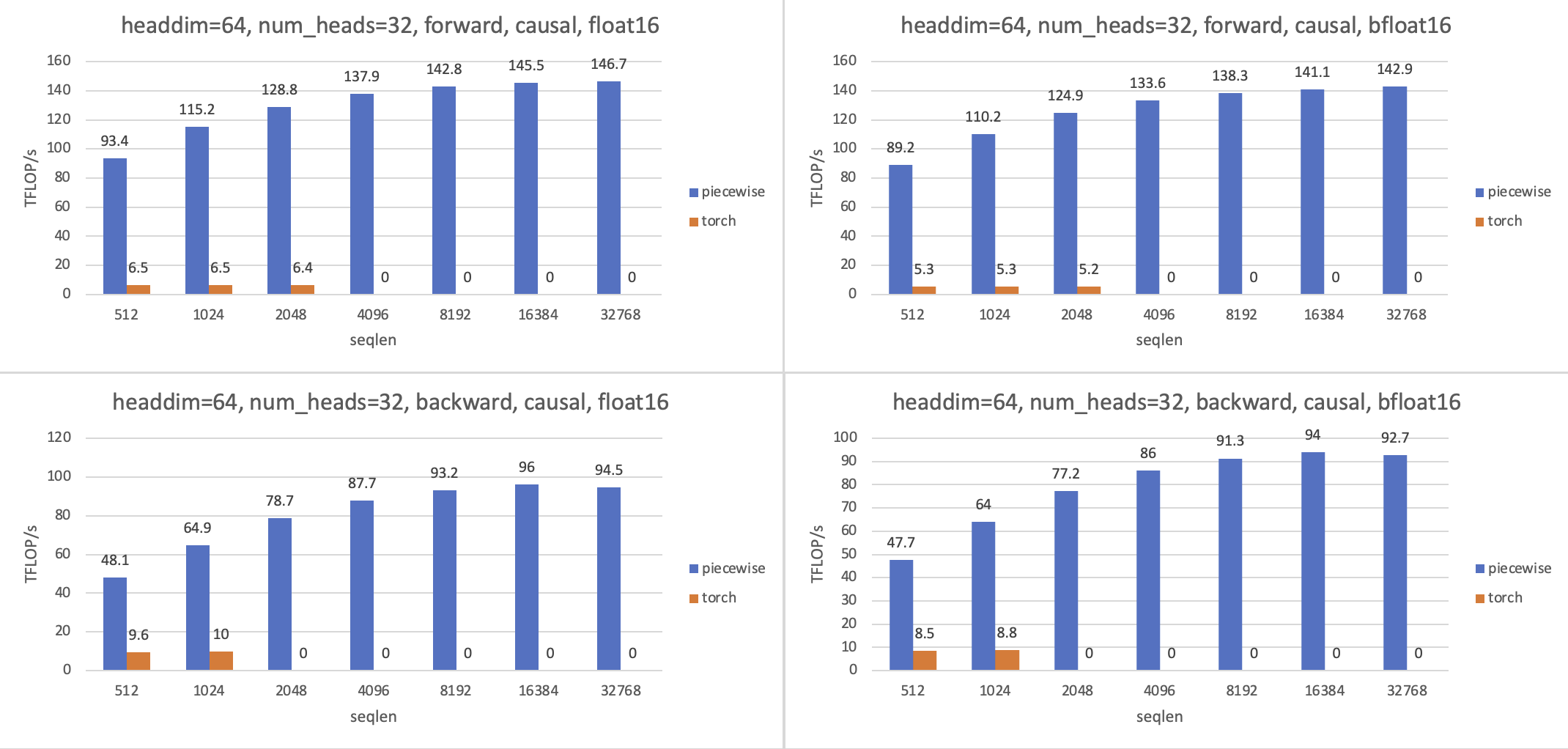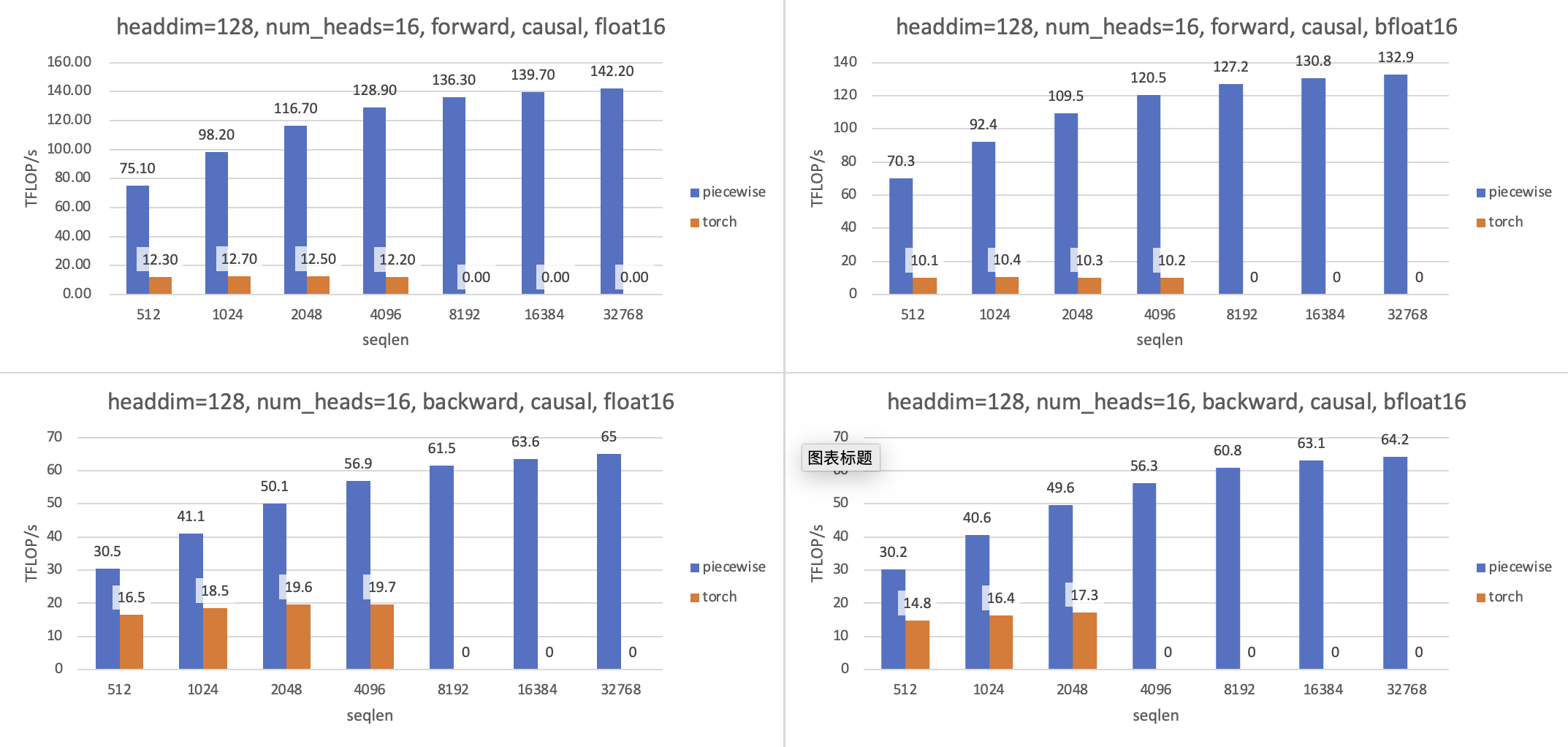FlagAttention is a project for memory-efficient attention operators implemented in the Triton language. It is inspired by FlashAttention and FlashAttention v2 and extends them to satisfy the needs for research on large language modeling. FlashAttention and FlashAttention-2 save memory footprint and traffic to improve memory efficiency, but to modify them and add more options and functionalities requires proficiency in cuda programming. Thus, Flag Attention is implemented in the Triton language, which is easier to use to write custom GPU kernels.
The operators provided by FlagAttention are memory-efficient and run fast, like FlashAttention, which scales large language models to longer sequences. As an out-of-the-box collection of efficient attention operators, FlagAttention balances efficiency and generality. FlagAttention makes extensions to the basic functionalities instead of tailor-made operators for every detail of a specific model. PiecewiseAttention is currently used for inference in the Aquila 34B model, but it can also be used by other models.
When further customization is needed, FlagAttention can also be a reference or starting point.
FlagAttention requires Pytorch and Triton. To use the new features of Triton, Triton nightly is recommended.
Instructions to install Pytorch nightly can be found at https://pytorch.org/get-started/locally/ . Triton is now a dependency of torch nightly, so it can be installed automatically.
FlagAttention requires Ampere Nvidia GPUs(e.g. A100, RTX-3090, ...) and CUDA Toolkit 11.6 and above. Other GPUs may work but have not been tested yet.
FlagAttention can be installed in either way below.
- Editable Installation. Changes to the code in local source tree are effective without re-installation.
- Build a distribution and then install. Only the package is installed.
Editable installation with pip.
git clone https://github.com/FlagOpen/FlagAttention && cd FlagAttention
pip install -e .Following modern python packaging convention, FlagAttention is configured by pyproject.toml, and no setup.py is provided. To build a distribution, either a source distribution or a binary distribution, python package build is recommended.
First, install build package via pip.
pip install buildThen build the package.
git clone https://github.com/FlagOpen/FlagAttention && cd FlagAttention
# to build in `no-isolation` mode requires installing build requirements manually
pip install -U setuptools setuptools-scm
python -m build --no-isolationThe built package is in dist/ for installation.
pip install dist/flag_attn-xxx.whlFlagAttention provides customized attention operators. When an operator is equivalent to a torch function, it can be used as a drop-in replacement.
A recent version of pytest(>=7.1.0) is required to run the tests in tests/. Operators in FlagAttention are tested against a reference implementation in pytorch, both forward and backward. For operators with support for inputs of float16 or bfloat16, three different implementations are included for numerical accuracy testing.
- The implementation used as reference is an implementation in PyTorch which upcasts the inputs to
float32and performs the computations infloat32all the way through before casting the outputs tofloat16orbfloat16. - The implementation in Triton usually uses
float16orbfloat16for mma(matrix multiplication accumulation) inputs, andfloat32for mma outputs and other computations. - The implementation for comparison is an implementation in PyTorch, with the same computation as the reference, except that the precision is the same as the Triton implementation.
The tests for numerical accuracy enforce that the max difference between the Triton implementation and reference implementation is not greater than twice the max difference between the Pytorch implementation and reference implementation.
pytest .Benchmarks are provided to measure the TFLOPs/s achieved. FLOPs/s is used as a metric for speed of the operator. To calculate the FLOPs of an operator, only matmul is counted. The FLOPs is divided by the median runtime to get the achieved FLOPs/s.
We benchmark operators in Triton implementation against a reference implementation in Pytorch. When the input size is large, the reference implementation in Pytorch runs out of memory. In such cases, the FLOP/s is treated as zero.
The speed of Flash Attention v2 (https://github.com/Dao-AILab/flash-attention, v2.2.3) with the same size of inputs is also provided as a reference. But since operators in FlagAttention deviates from Flash Attention, the total amount of computation is different even when batch size, sequence length, number of heads, head dimension, and other configurations are the same.
The first extension of Flash Attention is piecewise attention.
The interface is shown below.
piecewise_attention(q1, k1, q2, k2, v, dist_threshold, softmax_scale=None, causal=False)It is named piecewise_attention in that it takes two q's and two k's to compute attention scores (S) before applying softmax to get the attention weights (P). The design originates from the fact that a transformer with rotary position embedding is not good at predicting sequences longer than the longest sequence that it is trained on. Pairs of (q, k) get unexpectedly high attention scores when the distance is greater than the maximum sequence length in the training set. A proposal to solve the problem is to compute the attention score in different ways, depending on whether the distance between q and k is greater than a threshold.
In practice, q and k can be preprocessed in two different ways to get q1, q2 and k1, k2. Then the attention score is computed as the dot product of q1, k1 or q2, k2 depending on the distance between q and k.
import torch
from flag_attn import piecewise_attn
B, H, T, D = 2, 16, 8192, 128
dist_threshold = T // 2
q1 = torch.randn((B, H, T, D), dtype=torch.float16, device="cuda:0").requires_grad_()
q2 = torch.randn((B, H, T, D), dtype=torch.float16, device="cuda:0").requires_grad_()
k1 = torch.randn((B, H, T, D), dtype=torch.float16, device="cuda:0").requires_grad_()
k2 = torch.randn((B, H, T, D), dtype=torch.float16, device="cuda:0").requires_grad_()
v = torch.randn((B, H, T, D), dtype=torch.float16, device="cuda:0").requires_grad_()
o = piecewise_attn(q1, k1, q2, k2, v, dist_threshold, causal=True)
print(o)
go = torch.randn((B, H, T, D), dtype=torch.float16, device="cuda:0")
gq1, gk1, gq2, gk2, gv = torch.autograd.grad(
o, (q1, k1, q2, k2, v), go
)
print(gq1)Performance for piecewise_attention with causal masking on A100 is shown below. Testing parameters are
- seqlen in
[512, 1k, 2k, 4k, 16k, 32k]; - batch size:
32k / seqlen; - headdim in
[64, 128]; - num_heads:
2048 / headdim.
- support for Nvidia Ampere GPU(Tested on RTX-3090 and A100);
- support for Iluvatar CoreX GPU(Tested on Iluvatar CoreX MR-V100);
- data type support, float16 and bfloat16 for Ampere Nvidia GPUs;
- support causal and non-causal modes.
- support forward & backward modes;
- the sequence length of k/v can be larger than that of q.
headdimshould be in[16, 32, 64, 128].- dropout of attention weights is not supported yet.
- Test on other GPUs;
- Test on more triton versions
- Improve performance of attention operators.
- Support other extensions to flash attention.


